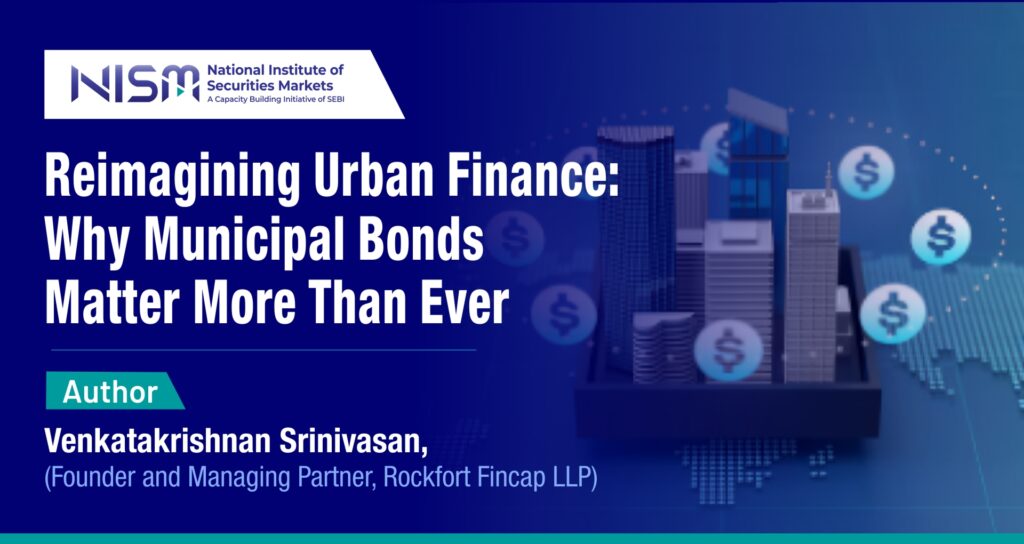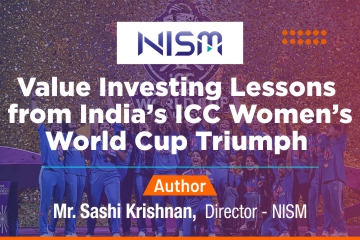
India’s urban transformation is accelerating—with over 600 million people projected to live in cities by 2036 and urban regions already contributing more than 63% of the country’s GDP, which by 2030 is expected to rise to 75%
Yet, the local bodies responsible for delivering this infrastructure—Urban Local Bodies (ULBs)—remain fiscally constrained. Most continue to depend heavily on state or central transfers, limiting their ability to plan long-term, capital-intensive projects. In this context, municipal bonds are no longer a niche innovation—they have emerged as a credible, structured, and scalable instrument to unlock infrastructure financing for Indian cities.
Municipal bonds are not new to India. The first was issued by Bengaluru in 1997, but the market remained dormant for two decades. A revival began post-2015, when SEBI notified its Issue and Listing of Municipal Debt Securities (ILDM) Regulations. Combined with reform-oriented programmes like AMRUT and the Smart Cities Mission, this regulatory foundation began attracting municipalities back to market. Today, SEBI’s sustained efforts are bearing fruit, with a growing number of ULBs discovering bonds as a strategic alternative to grant-dependency.
As of June 2025, 23 municipal bond issuances have been completed under SEBI’s framework, mobilising a cumulative ₹3,358.90 crore. The first quarter of FY2025 alone has seen a record ₹575 crore raised by six ULBs—Agra, Prayagraj, Varanasi, Greater Chennai Corporation, Pimpri-Chinchwad, and Gandhinagar and many more have queued up to tap the bond market this fiscal year.
Adding momentum, Suraj Municipal Corporation is preparing to launch a public issue of ₹200 crore (including a green shoe option)—a major step that will allow direct retail participation in India’s municipal bond market and expand its investor base. While most municipal bond issuances so far have been via private placements—favoured for their quicker execution, simpler compliance, and institutional targeting—there is a clear need to scale up public bond issuances to enable broader participation and deepen the investor base.
To further improve access to the bond market, SEBI has permitted privately placed bonds to carry a face value of ₹10,000, as an option, in line with public issues—subject to the appointment of a merchant banker.
A key reason for growing investor interest is the robust credit structuring seen in recent municipal bonds. Today’s bonds are typically backed by ring-fenced cash flows—such as property tax or user charges—deposited into escrow accounts. These are supported by additional security mechanisms like Debt Service Reserve Accounts (DSRA), Sinking Fund Accounts (SFA), and Interest Payment Accounts (IPA). This structured waterfall ensures prioritised debt servicing and has helped most issuances secure credit ratings in the AA or AA+ category, even when the underlying municipal finances remain modest.
The Ministry of Housing and Urban Affairs (MoHUA) has further strengthened the ecosystem through incentives under AMRUT 2.0. ULBs can receive ₹13 crore per ₹100 crore raised (up to ₹26 crore) as grant support. For those seeking a second round of incentives, the bond must qualify as a green bond under SEBI’s NCS framework—eligible for ₹10 crore per ₹100 crore raised (up to ₹20 crore), provided the funds are used for climate- aligned sectors like water, sanitation, renewable energy, or urban resilience. MoHUA has also extended this incentive to pooled municipal bonds, allowing smaller ULBs to aggregate their borrowing through state-level pooled finance entities.
Green and ESG-linked bonds are fast becoming the next frontier. Cities like Indore, Ghaziabad, and Pimpri-Chinchwad have issued green municipal bonds that were well received in the market—several being oversubscribed. These issuances are aligned with SEBI’s green debt security framework, which mandates use-of-proceeds tracking, external certification, and anti-greenwashing safeguards—bringing Indian muni bonds closer to international ESG standards.
In the early stages of this market’s evolution, the U.S. Treasury Department’s Office of Technical Assistance (OTA) played a catalytic role. Under a 2020 MoU with MoHUA, the OTA supported few Indian municipalities—including Pune and Vadodara—in building bond issuance capacity through financial modelling, structuring guidance, and investor preparation. One of the standout cases was Vadodara Municipal Corporation (VMC), which issued a ₹100 crore bond in 2022. It was oversubscribed ten times, and with AMRUT incentives factored in, brought the effective coupon down to 4.55%, which is an achievement, even much below the AAA rated bond issuers.
Vadodara’s success was rooted in strong governance. It had adopted accrual-based accounting, ensured timely audits, and clearly linked bond proceeds to defined infrastructure outcomes. Its example has become a reference point for other tier-2 cities aspiring to access bond markets effectively.
To help guide others, VMC also recently published a detailed case study booklet titled “The Green Book,” which documents their entire green bond issuance journey—challenges, structuring process, stakeholder coordination, and lessons learned. This resource now serves as a valuable reference for other municipalities exploring similar capital market access besides the SEBI Municipal Debt Securities – Repository web portal.
Despite this momentum, key challenges remain. A majority of ULBs are unrated or fall below investment grade. Revenue autonomy is weak, with most cities depending on transfers rather than generating their own income through property tax or user fees. Financial reporting remains inconsistent, with many cities yet to adopt the National Municipal Accounting Manual (NMAM).
Without a strong project pipeline backed by ring-fenced revenue flows, investor appetite remains cautious. The lack of a dedicated municipal insolvency framework also creates legal uncertainty for long-term bondholders. Moreover, India still lacks a deep secondary market for municipal debt, restricting exit options for investors.
Going forward, policy and institutional innovation will be essential. SEBI, MoHUA, credit rating agencies, and intermediaries should collaborate to develop tailored rating methodologies suited to pooled structures, green bonds, and hybrid guarantees. Tax rebate, if considered, could further broaden the investor base, especially among retail and HNI segments looking for stable, tax-efficient returns.
Multilateral development banks (MDBs), ESG-focused investors, and impact funds should also consider actively participating in India’s municipal bond space—especially where proceeds are earmarked for green and socially sustainable urban infrastructure. Their involvement could deepen market credibility, support capacity-building, and help unlock blended finance models in cities that need both capital and technical handholding.
India’s cities are at the heart of the country’s economic and demographic future. But the infrastructure they require cannot be financed through grants and subsidies alone. Municipal bonds—whether issued through public offerings or private placements—are emerging as a vital bridge between capital markets and urban development. When transparently structured and professionally managed, these instruments can instil fiscal discipline, unlock long-term funding, and enable cities to move from grant-dependency to true creditworthiness. As we reimagine urban finance, municipal bonds are no longer just an option—they are an essential pillar for building resilient, accountable, and investment-ready Indian cities.
Venkatakrishnan Srinivasan
Founder and Managing Partner
Rockfort Fincap LLP
Venkatakrishnan Srinivasan (Venkat) is a veteran of India’s bond market, with over 30 years of expertise in Indian Rupee Bonds and Debt Capital Markets. His career spans guiding debt transactions from origination through execution, consistently delivering successful outcomes.
Before founding Rockfort Fincap LLP in late 2021, Venkat served as Senior Vice President at ICICI Securities Primary Dealership Limited (I-Sec PD) until June 2021.
Author: Venkatakrishnan Srinivasan, Founder and Managing Partner, Rockfort Fincap LLP

SIP and EMI: three-letter synonyms, but diametrically opposite You are king of your money or slave to your expenses SIP…

Watching the finals of the ICC Women’s World Cup Final, where the Indian Women’s Cricket Team defeated the South African…

In the complex architecture of India’s financial system, very few institutions have had as profound and far-reaching an impact as…
© 2025 National Institute of Securities Markets (NISM). All rights reserved.